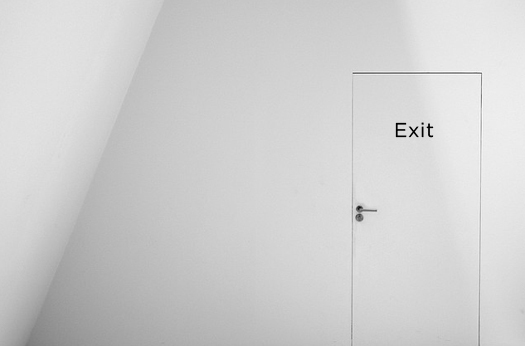
Exit The White Room, photo by Daniel B
Editor's Note: "Jeff Koons: A Retrospecitve" opens today at the Whitney in New York City. In August, 2011 Adam Harrison Levy wrote this about his expereince in Koons's studio.
Walking into Jeff Koons's studio is like entering a medical laboratory crossed with an open plan office. It’s a sanitized, technologized and infantilized version of Andy Warhol’s factory. In one room a group of assistants, dressed in medical scrubs and facemasks, bend over the prone forms of his famous Popeye Series sculptures. Powerful medical lights spotlight the scene as the assistants silently scrape away at their surfaces with gleaming metal blades. It’s an ER room for art.
In another room immense wooden scaffolds are pulled up in front of giant canvases like gantries in front of a row of Apollo rockets. More assistants: this time daubing at rectangular pallets with pre-mixed colors. They apply the paint in total silence. It’s difficult to make out the paintings but they seemed to be classical History scenes run through the filter of a soft porn site — breasts and phallus’s but no money shot.
Everyone we meet in the studio are super nice and attractive — both men and women. The PR woman is nice and helpful, the people waiting for the bathroom are very nice and friendly (they insist I jump the line) and the art assistants are all smart and super-duper nice. If any of them had stayed up into the small hours of the morning discussing the latest group show in Brooklyn, or reading Dave Hickey, or even working on their paintings, craftings or interactive Internet pieces, it didn’t show. They looked as if they had their full eight hours of sleep and didn’t drink coffee. They looked like hipsters on Xanax.
I don’t romantize the cocaine fueled midnight to dawn, anorexic, disco dancing 1970s art scene. But I did wonder about the sense of other worldly calm that pervaded the studio.
Koons wasn’t sure where he wanted the interview to take place. His PR woman had informed us (nicely) that we couldn’t do it in the immense painting studio because shots of the images were out-of-bounds. When Koons arrived (looking clean and trim in a blue polo necked shirt and tasteful soft leather black shoes) he directed us to the office. The cameraman was disgruntled — it would be a boring shot and the lighting was all wrong. The soundman indicated that we were going to have problems with the telephones. But we didn’t seem to have a choice.
We started to set up. A flicker of concern crossed Koon’s face. He consulted with the office manager. He didn’t look pleased either; we might be able to glimpse content on the immense flat computer screens on which assistants were working on designs, concepts and general office administration.
We packed up our equipment and followed Koons as he strode down a corridor. While walking he deftly bent down and removed a piece of black gaffer tape that was stuck to the floor. We then entered the “sculpture” room which contained the casts from the Popeye series that have proved so successful for his career.
It was work from a number of years ago and Koons didn’t to be identified with it anymore. We then walked back down the corridor and entered the immense painting space. He looked around and was about to leave. He was (nicely) giving us the run-around. The camera crew came to a full stop. They stood stock still like stubborn mules. They weren’t going to lug their equipment anymore; we were losing time. The soundman began to set up his boom stand and the cameraman unfolded his tripod.
I mustered my best inner Cecil DeMille.
“Wonderful location. Thanks. This will do perfectly.”
I turned my back on Koons, looked down at my clipboard, and proceeded to give the crew totally inane directions. My foot was shaking.
We got the interview, just about. Koons was persuasively fluent and burnished like one of his large shiny sculptures. He brilliantly deflected any probing questions. He was a master of getting his message across.
Everyone relaxed and the PR woman allowed that we could re-enter the sculpture room, briefly take some “cut-away” shots of the sculptures and that Jeff would return for a brief, three to five minute mini interview in the new location. We did that and wrapped.
When a camera crew enters a location they decide on a staging area and unpack their gear. They assess the filming conditions, adjust accordingly, and set off lighter and fleeter with what they hope is the right equipment. What is left behind are their immense cases of lights, tripods, and sound equipment with their lids wide open. Extension cords trail on the floor, light stands are scattered about, rolls of colored gel are dumped in piles. It always looks chaotic and messy like a teenager’s room.
I’ve come to realize that there is a method at work here; each member of the crew knows exactly which case is where and they leave them open so that they can reach in quickly if a light blows or a battery runs out of charge. Tidying everything up would mean wasting valuable time in the midst of a shoot. You need instant access to your equipment.
After we had wrapped we walked back down the corridor and turned the corner into the foyer. We stood there stunned. All the cases had been closed up, the light stands had been lined up against the wall, extension cords had been wrapped into perfect concentric circles. None of Koons’ assistants looked up from their work. It was as if a band of Oompa-Loompas had scampered into the place, cleaned things up and had then scampered out again. We were then (nicely) shown the door.


Comments [11]
08.22.11
10:02
08.22.11
10:41
08.22.11
03:39
08.22.11
05:13
08.22.11
06:39
1. assistants, dressed in medical scrubs
2. assistants silently scrape away
3. assistants: this time daubing
4. assistants are all smart
5. assistants were working on designs
6. assistants looked up from their work.
7. like entering a medical laboratory
8. like gantries in front of a row of Apollo rockets.
9. like hipsters on Xanax.
10. like stubborn mules.
11. like one of his large shiny sculptures.
12. like a teenager’s room.
Thank you Adam!
08.23.11
12:48
08.24.11
12:20
08.25.11
07:55
08.26.11
04:15
The plural of “phallus” is phalli or in some cases “phalluses” but the latter may be a fallacy. By accident or design, fallacies may exploit emotional triggers in the listener.
08.26.11
10:41
08.27.11
12:21